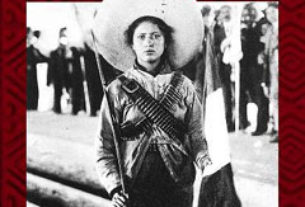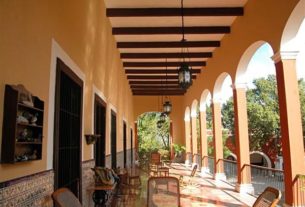Today, the visible remains of Mexico’s Colonial era are the ornate churches and palacios, either government office buildings or the homes of Colonial officials, still surviving, in the center of Mexico’s larger cities.
The palacios have thick walls and portales, broad covered walkways, with wide arches supported by pillars. They shelter sidewalk cafes, vendors of foods, jewelry, arts and crafts and sometimes a remnant of the past, scribes who write letters or documents for illiterates. Modeled on the architecture of Spain but modified by the native artisans who incorporated pre-conquest symbols, these largely baroque buildings are still in use and are major tourist attractions. Most of them rim the large zocalos, the central town squares of major cities. Even today these plazas are the focal point of city life. The original centers of colonial cities have a grid of streets running north-south and east-west. This arrangement, modeled on the plan of Renaissance era city design in Europe, was also how the indigenous Mexicans built their cities and the newcomers simply tore down the native temples and palaces and replaced them with similar structures, preserving the original plaza.
The Colonial Government of Nueva Espagna dates from 1530 when the first royal Viceroy, Antonio de Mendoza, started to bring order from chaos. Although it was to rule what is now Mexico for almost 300 years and had many positive achievements, it must be deemed a failure because it put in place political and social systems that launched the revolt against Spanish rule. Its unwillingness to give what had become the majority of the population any voice in government or control over their own destiny was to persist even in the “democratic ” Republic that replaced it.
From the very beginning, the Spanish Crown’s control over Nueva Espagna, its colony that was to become Mexico, was minimal. Part of this was due to the length of time it took for communications to move from Spain to the New World. But an even larger reason was the character of Hernan Cortes and the men who accompanied him as he conquered the Aztecs. It is not surprising that Cortes whose entire Conquest of Mexico was an illegal rebellion against the orders of his superior, the Governor of Cuba, chose to disregard any orders that interfered with his goal of self-enrichment.
In 1521 when the Aztec Empire fell, Cortes, began to rule the Colony. Appointed Captain-General, with only an Audencia, a Church Court, to share his power, he rewarded the Spaniards who had helped him conquer the country with vast land grants called Ecomiendas. He also permitted them to enslave all Indians who lived within the boundaries of these estates. In 1493, Pope Alexander VI had granted Spain the right to colonize what is now Mexico, all of Central America, and the land that now makes up Texas, New Mexico, Arizona, Colorado and California. While doing so he had mandated that the indigenous people be converted to Catholicism and prohibited their enslavement. However, his order had a “catch 22” in which he said that any natives who rejected Christianity, or once baptized, reverted to their old religion, should be punished and could be enslaved. While Cortes was very dedicated to bringing religion to the Indians, during the Conquest, after baptism, no religious instruction was offered to those he converted.
Thus they had no real grasp of Christianity and it was easy for Cortes, always a Machiavellian manipulator, to claim the natives still worshiped their old Gods and could legally be enslaved. But he was also violating a very specific order issued in 1500 by Queen Isabella of Spain who had expressly proclaimed, “all Indians of the Spaniards were to be free from slavery.” When she died in 1504, her will instructed her successors to continue these policies. This tendency to either ignore orders or modify them to suit local officials still lies hidden beneath the modern political and social systems of modern day Mexico. Cortes had established himself as a Caudillo, the strong man who rules alone. This theory of one-man rule that can be traced back to the Colonial period was the norm in Mexico until quite recently. Legislative bodies simply rubber stamped the Caudillo’s decisions.
When in 1530, the first Royal Viceroy, Antonio de Mendoza, took control, one of his first positive achievement was to regulate the treatment of the native peoples. But he too ignored another edict banning slavery that Juan de Zumarraga, the first Bishop of Chiapas, had obtained from the Spanish Crown that very same year. However, aided by Bartoleme de las Casas, first Archbishop of Mexico who became the “Protector of the Indians” the newborn Colonial government did set standards for the treatment of slaves.
Now, no slave could be forced to carry a burden heavier than 100 lbs. Officials were appointed to insure that “free Indians” were actually paid for their work. Soon afterward, under Vasco de Quiroga, Bishop of Chiapas, schools and hospitals that served Indians, both enslaved and free, were established. A more humane treatment of all indigenous people must certainly be credited to the efforts of the Colonial Government. The government also confirmed the existence of native municipalities. While Indian officials handled administrative affairs, an alcalde mayor was the real boss. He, too, was a Caudillo whose word was law. Later, the Colonial government created an Ejido system that gave these native municipalities land grants to protect them from being forced to abandon their villages by new immigrants.
Although, in 1859, Benito Juarez and the Liberal Party destroyed the Ejido system, later, it was revived and Ejidos still exist. Yet this “protection” in a sense impinged badly on the Indians, for it isolated them and bound them solely to agriculture.
The political system set up to run the country was modeled on that of Spain. Municipalities became the territorial unit of government. Largely self-governing, the Crown was represented by an alcalde mayor appointed by the Viceroy. These appointments contained one of the first seeds of popular discontent. With very few exceptions, only Spaniards, born in Spain, were given these positions. This policy was still in effect in 1810 at the start of the Mexican Revolution. Proclaiming his “Grito” on September 16th of that year, Father Miguel Hidalgo closed by shouting, “Death to the Gachupines. Literally translated as “spur wearers” it was the popular term describing Spaniards born in Spain.
Additionally, municipal freedom from central control came about because of difficulties of rapid communication with the central government in Mexico City. By 1571 there were 35 Spanish founded “royal” municipalities and by 1624, 82. As the population increased, Nueva España expanded. Nuevo Galicia now Jalisco, Nuevo Leon now Leon and finally Nuevo Mexico now Texas, Arizona, and New Mexico, became self-governing gobiernos largely unsupervised by the central government. This tradition of independence from central authority is still part of the Mexican scene. Governors of Mexican States routinely ignore or modify federal directives and presidentes ( mayors) of cities do the same with edicts from both state capitals and Mexico, D.F. Even the Mexican bureaucracy at times ignores the letter of the law.
The social system set up under the Colonial Government was, in the end, a major contributor to its failure since it froze the society, offering almost no chance of upward mobility. At the head of the pecking order were Spaniards born in Spain. Second but still well beneath them were the Criolles, people of pure Spanish blood born in the Colony. This group held secondary positions in the Government, Church and Army. Together with those born in Spain, they formed the elite group that ran the colony. Unions between Spaniards and indigenous people, almost always men with women, produced mestizos. By 1810 they were the majority of the population. Last in both social status and opportunity, were the Indians. Frozen into this rigid system, based on place of birth and bloodlines rather than ability, resentment between the various segments of society was inevitable. It was the Criolles who led the Mestizos in the revolution that broke the Spanish yoke.
Spain’s interest in Nueva Espagna was almost totally economic. The welfare of the settlers was of little concern to the Crown. As long as a steady flow of silver, gold spices and tobacco enriched the royal coffers, local officials had almost complete independence. They competed for absolute power only with the Catholic Church. As time went by Government and Church built a power-sharing alliance that institutionalized the class system. Laws forbidding trade with any country other than Spain stifled chances for industrial development. The colony was regarded as simply a source of raw materials. Mining and agriculture, the principal source of raw materials, offered only menial, backbreaking jobs. Thus after the flood of Conversos who came to Nueva Espagna in the 1530’s, seeking refuge from the Inquisition, migration to the Colony was a mere trickle.
In the final analysis, the Colonial Government mirrored Spain. The concept of democracy was alien to the Spanish crown. This, too, is part of the legacy that produced the chaos after Independence was achieved. In the first 55 years of the Republic, 75 Presidents came and went. One of them, Santa Anna, served twelve times. It is only in the last 20 years that true democracy has started to emerge. Blaming this entirely on the Colonial Government is an over-simplification, but there is little doubt that many of the practices of the 300 years that it controlled the Colony, either knowingly or sub-consciously, still make up part of the Mexican Mystique.



